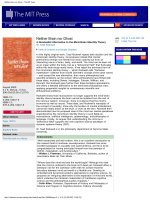The economics of microfinance (the MIT press)
Bạn đang xem bản rút gọn của tài liệu. Xem và tải ngay bản đầy đủ của tài liệu tại đây (1.91 MB, 491 trang )
The Economics
of Microfinance
s e c o n d
e d i t i o n
Beatriz Armendáriz
Jonathan Morduch
www.ebook3000.com
The Economics of Microfinance
www.ebook3000.com
www.ebook3000.com
The Economics of Microfinance
Second Edition
Beatriz Armendáriz and Jonathan Morduch
The MIT Press
Cambridge, Massachusetts
London, England
www.ebook3000.com
© 2010 Massachusetts Institute of Technology
All rights reserved. No part of this book may be reproduced in any form by any electronic
or mechanical means (including photocopying, recording, or information storage and
retrieval) without permission in writing from the publisher.
For information about special quantity discounts, please email special_sales@mitpress.
mit.edu.
This book was set in Palatino by Toppan Best-set Premedia Limited.
Printed and bound in the United States of America.
Library of Congress Cataloging-in-Publication Data
Armendáriz, Beatriz.
The economics of microfinance / Beatriz Armendáriz and Jonathan Morduch.—
2nd ed.
p. cm.
Includes bibliographical references and index.
ISBN 978-0-262-01410-6 (hardcover : alk. paper)—ISBN 978-0-262-51398-2 (pbk. : alk.
paper) 1. Microfinance. I. Morduch, Jonathan. II. Title.
HG178.3.A76 2010
332—dc22
2009034760
10 9 8 7 6 5 4 3 2 1
www.ebook3000.com
A Georges-Antoine, Mikhaela y Eduardo. Con amor.
To Amy, Leon, Joseph, and Samuel
www.ebook3000.com
www.ebook3000.com
Contents
Preface to the Second Edition ix
Preface to the First Edition xiii
Acknowledgments xvii
1
Rethinking Banking
1
2
Why Intervene in Credit Markets?
3
Roots of Microfinance: ROSCAs and Credit Cooperatives
4
Group Lending
5
Beyond Group Lending
6
Savings and Insurance
7
Gender
8
Commercialization and Regulation
9
Measuring Impacts
10
Subsidy and Sustainability
11
Managing Microfinance
29
97
137
169
211
239
267
317
347
Notes 383
References 409
Abbreviations 439
Name Index 443
Subject Index 449
www.ebook3000.com
67
www.ebook3000.com
Preface to the Second Edition
When we started writing this book in 1998, the idea of microfinance
was already gaining ground. But it did not fully burst onto the global
scene until around the time that the first edition of The Economics of
Microfinance was published in 2005. The year 2005 marked the United
Nations International Year of Microcredit, a worldwide celebration
that engaged banks, governments, philanthropists and the media. Kofi
Annan, then Secretary-General of the United Nations, lauded the social
promise of microfinance as “an integral part of our collective effort
to meet the Millennium Development Goals” (United Nations 2003).
In November 2005, The Economist devoted a special supplement to
microfinance with a decidedly commercial slant. Newspapers,
blogs, and television shows started to cover microfinance with
greater frequency. The UN year was followed by the announcement
in Oslo that the 2006 Nobel Peace Prize would go to Muhammad
Yunus and Grameen Bank, the most visible microfinance pioneers.
The Nobel Prize brought even more media attention, investment, and
research.
Microfinance itself has also been transforming. When we started
writing the first edition, the most comprehensive global count of microfinance customers totaled 13 million customers. By the time the first
edition went to press, the count had reached 67 million. By the end of
2007, the number had swelled to 155 million, with $5.4 billion invested
in the sector in that year. By the time you read this, the number of
customers may well exceed 200 million. Many are women: the most
recent count shows that women made up 71 percent of the 155 million
customers at the end of 2007 (Daley-Harris 2009).
The expansion of scale and investment has brought new ideas and
new debates. Like the first edition of this book, the second edition aims
x
Preface to the Second Edition
to provide an honest reckoning rather than a pure celebration. Most in
the microfinance sector have embraced the pursuit of profit, but not
with identical degrees of ease and enthusiasm. If there is one unresolved tension that animates those who spend their days working on
microfinance, it entails how to navigate the trade-offs between maximizing social impact and building strong, large financial institutions.
It is a healthy tension, but an inescapable one.
New to this edition is a chapter on commercialization. We take up
tensions and debates directly, define financial terms, and give an
empirical assessment of the full financial landscape so far.
The past six years have also seen an outpouring of work on savings
and insurance, much of it framed within the emerging academic field
of behavioral economics. The first edition strongly pointed in the direction in which the work proceeded, and we’re pleased to describe new
ideas and evidence. Chapter 6, on savings and insurance, is thus considerably bulked up.
Chapter 9, on impact evaluations, has also grown. When we wrote
the chapter for the first edition, we had to conclude that more evaluations should be done—and we awaited them. As we go to press for the
second edition, we can happily report on a handful of excellent new
studies. Perhaps more important, we can report on a set of newly
refined evaluation tools based on randomized control trials. The new
results show mixed impacts of microfinance. Microfinance advocates
may be disappointed by the lack of stronger results so far, but the evidence should be taken as a prompt to return to basic assumptions with
an eye toward improved solutions.
Apart from these large changes, we have taken the chance to update
data and describe new studies in nearly every chapter. Chapter 7 on
gender and microfinance has been particularly revised, reflecting the
importance of women among microfinance customers—and as agents
of social change in their families and communities.
As with the first edition, familiarity with economics will help,
and we use mathematical notation where it clarifies arguments, but
the main points can be understood without the math. We have
especially tried to make the book engaging for undergraduates and
graduate students in economics and public policy (and have fully
updated the exercises at the end of each chapter; as before some are
written for advanced economics students with a desire for analytical
challenge).
Preface to the Second Edition
xi
We were pleased to find that microfinance practitioners and policymakers found useful discussion in the first edition. In response,
the second edition is even more focused on drawing analytical
lessons that extend outside the bounds of classrooms and seminar
rooms.
Beatriz Armendáriz
Jonathan Morduch
Preface to the First Edition
Microfinance is one of those small ideas that turn out to have enormous
implications. When Muhammad Yunus, an economics professor at a
Bangladesh university, started making small loans to local villagers in
the 1970s, it was unclear where the idea would go. Around the world,
scores of state-run banks had already tried to provide loans to poor
households, and they left a legacy of inefficiency, corruption, and
millions of dollars of squandered subsidies. Economic theory also provided ample cautions against lending to low-income households that
lack collateral to secure their loans. But Yunus vowed to one day make
profits—and he argued that his poor clients would pay back the loans
reliably. Today, Muhammad Yunus is recognized as a visionary in a
movement that has spread globally, claiming over 65 million customers
at the end of 2002. They are served by microfinance institutions that
are providing small loans without collateral, collecting deposits, and,
increasingly, selling insurance, all to customers who had been written
off by commercial banks as being unprofitable. Advocates see the
changes as a revolution in thinking about poverty reduction and social
change, and not just a banking movement.
The movement has grown through cross-pollination. Muhammad
Yunus’s Grameen Bank has now been replicated on five continents.
Approaches started in Latin America have found their way to the
streets of El Paso and New York City; experiments in Bolivia have
given birth to institutions in Uganda and Azerbaijan; and policymakers
in the world’s two most populous countries, India and China, are now
developing their own homegrown microfinance versions. Recognizing
the energy and activity, the United Nations designated 2005 as the
International Year of Microcredit.
This book is about the ideas that have driven the movement. It is
also about lessons that the movement holds for economics and, more
xiv
Preface to the First Edition
specifically, for thinking about why poor people stay poor—questions
that, at some level, go back to Adam Smith’s inquiry into the wealth
and poverty of nations. Microfinance successes force economists to
rethink assumptions about how poor households save and build assets,
and how institutions can overcome market failures. In telling the story,
we draw on new developments in economic theories of contracts and
incentives, and we also point to unanswered questions and ways to
reframe old debates.
There is a great deal already written on microfinance, both by practitioners and academic economists, but the two literatures have for the
most part grown up separately and arguments have seldom been put
into serious conversation with each other. Both literatures contain valuable insights, and both have their limits; one of our aims in this book
is to bridge conversations, to synthesize and juxtapose, and to identify
what we know and what we need to know. In this way, this book is
both retrospective and prospective.
Combining lessons from the classroom and the field is natural for
us. Armendáriz, apart from contributing to the theory of banking in
her academic role, founded the Grameen Trust Chiapas in Mexico in
1996, the first replication of the Grameen Bank in Mexico. While writing
this book, she devoted much time to the Chiapas project as it went
through major reorganizational changes. At the same time, Morduch
was carrying out research in Bangladesh, advising projects at Bank
Rakyat Indonesia, and analyzing financial data he had helped collect
in Chinese villages.
We have been thinking about this book since 1998, when Morduch
was visiting Princeton University and Armendáriz was visiting the
Massachusetts Institute of Technology. Our common concern at the
time was that our respective field experiences in Asia and Latin
America did not seem to accord well with the growing theoretical
literature, with its focus on group lending contracts to the exclusion of
most else. Broader ideas were needed to create workable microfinance
institutions in sparsely populated areas, in urban areas, and in the
Eastern European countries that were making the transition from
Communism to capitalism. Even in the densely populated rural and
semi-rural areas where microfinance had first taken root, we saw a
variety of mechanisms that were already at work and that economists
had so far ignored. This prompted us to undertake our first joint project,
“Microfinance Beyond Group Lending” (Armendáriz and Morduch
2000).
Preface to the First Edition
xv
Although we had written drafts of the opening chapters in 1998,
good intentions were displaced by other research projects and travel.
Two events made us return to the book. One was a grant from the ESRC
to Armendáriz, and another was Morduch’s research leave at the University of Tokyo in 2001–2002. We then resumed writing the book and
started rethinking what we had learned.
The result is a book on the economics of microfinance that we hope
will be useful for students, researchers, and practitioners. We hope
that, in different ways for different readers, the book will challenge
received wisdom and provoke richer understandings of economic
institutions.
Beatriz Armendáriz
Harvard University and
University College London
Jonathan Morduch
New York University
Acknowledgments
The chance to write a second edition is dangerous. If starting to
write a book is hard, finishing a book is harder. Writing the second
edition was made more exciting and more complicated by the fact
that so much new thinking and evidence has emerged in the six
years between completing the first edition and completing this one.
We have incurred many debts in staying on top of the latest
developments.
In writing the book, our views have been shaped and challenged
by many colleagues, including Patricia Armendáriz, Abhijit Banerjee,
Tim Besley, Patrick Bolton, François Bourguignon, Anne Case,
Maria Leonor Chaingneau, Daryl Collins, Jonathan Conning, Robert
Cull, Angus Deaton, Asli Demirgüç-Kunt, Mathias Dewatripont,
Esther Duflo, Bill Easterly, Maitreesh Ghatak, Xavier Giné, Christian
Gollier, Claudio González-Vega, Charles Goodhart, Denis Gromb,
Marek Hudon, Dean Karlan, Michael Kremer, Marc Labie, Jean-Jacques
Laffont, Valerie Lechene, Julio Luna, Malgosia Madajewicz, Maria
Maher, David McKenzie, Lamiya Morshed, Sendhil Mullainathan,
Mark Pitt, Jean Tirole, Robert Townsend, Ashok Rai, Shamika
Ravi, Debraj Ray, David Roodman, Ariane Szafarz, Lucy White, and
Jacob Yaron.
We also thank the many policy analysts and practitioners who
have taken time to share their views and experience. Armendáriz
gratefully acknowledges collaboration from the Board of Grameen
Trust Chiapas and, in particular, from Rubén Armendáriz Guerra,
Maricela Gamboa, Karina López-Sánchez, Francisco and Virginia
Millán, and Regis Ernesto Figueroa. She is particularly grateful to the
members of the Grameen Crédit Agricole Microfinance Foundation,
and, especially, to Raphaël Appert, René Carron, Yves Coutourier,
Agnès de Cleremont Tonnerre, Luc Démazure, Huzzat Latifee, Daniel
xviii
Acknowledgments
Lebèque, M. Shahjahan, Jean-Luc Perron, and Muhammad Yunus. She
is particularly grateful to Jean-Luc Perron and Emmanuel de Lutzel for
their intellectual and logistical support. Beatriz Armendáriz thanks
Alissa Fishbane, Dean Karlan, and Sendhil Mullainathan for great
insights and support in developing a randomized control trial in southern Mexico; Neka Eza’s hard work in supervising the surveys was
incredibly helpful.
Morduch thanks especially Vikram Akula, Daryl Collins, Carlos
Danel, Frank DeGiovanni, Asif Dowla, Chris Dunford, Syed Hashemi,
Don Johnston, Elizabeth Littlefield, Imran Matin, Nachiket Mor, Lynne
Patterson, Beth Rhyne, Marguerite Robinson, Jay Rosengard, Stuart
Rutherford, and Tony Sheldon.
Fortunately, we were able to work with a group of talented and
energetic individuals. We are particularly indebted to Catherine Burns
for her active participation as researcher, writer, and editor on the
second edition. Caitlin Weaver ably managed research assistants at
the Financial Access Initiative, and Jonathan Bauchet helped overhaul
the new chapter on impact evaluation.
Syed Hashemi, Stuart Rutherford, Mark Schreiner, Richard Rosenberg, and five anonymous reviewers provided detailed comments on
an early version of the first edition, and their suggestions greatly
improved the manuscript. Dale Adams, Marc Labie, Shamika Ravi, and
Adel Varghese gave specific comments which shaped parts of the
second edition.
Minh Phuong Bui wrote a set of exercises that accompanied the first
edition, and we appreciate her useful feedback overall. Sarah Tsien
provided research assistance on the first edition. Emily Wang gave
helpful feedback on the first edition, and drafted challenging exercises
for chapter 8 of this second edition. Stimulating conversations with
Katherine Prescott and Annabel Vanroose are gratefully acknowledged.
Alex Kaufman provided exceedingly useful comments and ideas for a
new set of exercises, and José Ignacio Cuesta reviewed and re-drafted
the exercises for the second edition. Beatriz Armendáriz is particularly
grateful to Alex and José Ignacio who were there, by her side, at all
times, reading every chapter and delivering most useful comments and
suggestions for challenging exercises.
Jane Macdonald, our editor at the MIT Press, proposed the second
edition and confidently steered the process to completion. We also
thank John Covell at MIT for supporting the project.
Acknowledgments
xix
Morduch gratefully acknowledges financial support from the Ford
Foundation and from the Gates Foundation and AIG through the
Financial Access Initiative. (The views expressed here, and any errors,
are attributable to the authors only.)
Last, we thank our families. Beatriz Armendáriz thanks GeorgeAntoine Capitani for his intellectual and moral support while writing
the second edition. Jonathan Morduch thanks Amy Borovoy for her
intellectual partnership.
The Economics of Microfinance
1
1.1
Rethinking Banking
Introduction
In March 1978, seven years after Bangladesh won its war for independence, a small group of young men joined together to make a secret
pledge. They vowed to create a new and dynamic organization dedicated to fighting rural poverty. Some saw Bangladesh’s plight as hopeless, as the country struggled in a world increasingly divided between
haves and have-nots. Thirty years later, however, the organization
started by the young men serves nearly six million villagers in
Bangladesh and is celebrated by global business leaders. The Association for Social Advancement (now best known by its acronym, ASA)
targets Bangladesh’s poorest villagers, many of them women, offering
tools to create better lives. ASA found success by applying fundamental lessons from economics and management, coupled with important
(and not obvious) new insights. In the process, ASA is expanding
financial markets and creating fresh ways to think about business strategies, economics, and social change.1
The hurdles have been high and ASA’s leaders have had to rethink
their plans more than once. While ASA started with a commitment to
fomenting political transformation, its course shifted radically. Today
ASA is squarely a bank for the poor, headquartered in a new office
tower in Bangladesh’s capital. In this, ASA stands as part of a global
“microfinance” movement dedicated to expanding access to small-scale
loans, savings accounts, insurance, and broader financial services in
poor and low-income communities. Their bet is that access to microfinance can offer powerful ways for the poor to unlock their productive
potential by growing small businesses. Increasingly, the focus is also on
helping customers save for the future and create more stable lives. In
2
Chapter 1
doing so, ASA and institutions like it are challenging decades of
thinking about markets and social policy in low-income communities.
ASA’s customers borrow on average around $120 per loan, and
repay the loans over the better part of a year. Traditional commercial
banks avoid this population. First, the loans are so small that profits
are typically hard to find, and, second, lending seems risky since the
borrowers are too poor to offer much in the way of collateral. But at
the end of 2008 ASA reported loan recovery rates of 99.6 percent, and
their reported revenues have fully covered costs in every year since
1993.
For many observers, microfinance is nothing short of a revolution or
a paradigm shift (Robinson 2001). Innovators are profiled in leading
newspapers and business magazines (in December 2007, ASA topped
Forbes magazine’s global ranking of microfinance providers), and
the 2006 Nobel Peace Prize, awarded to the microfinance pioneers
Muhammad Yunus and Grameen Bank, signals the ways in which
microfinance has shaken up the world of international development.
One of the most striking elements is that the pioneering models grew
out of experiments in low-income countries like Bolivia and Bangladesh—
rather than from adaptations of standard banking models in richer
countries.
Entrepreneurs, academics, social activists, and development experts
from around the world have been attracted by the lessons about retail
banking through microfinance, as well as by the promise that banks
like ASA hold for getting much-needed resources to underserved populations.2 Scores of doctoral dissertations, master’s theses, and academic studies have now been written on microfinance. Some focus on
the nontraditional contracts used to compensate for risks and to address
information problems faced by the microlenders. Others focus on
microfinance as a way to better understand the nature of markets in
low-income economies—with possible lessons for how to supply insurance, water, and electricity through markets rather than through
inefficient state-owned companies. Still others focus on the ways that
microfinance promises to reduce poverty, fight gender inequality, and
strengthen communities. This book provides a critical guide to some
of the most important new ideas.
The ideas give reasons for hope. Banks and NGOs like ASA are
flourishing at a time when the effectiveness of foreign aid to ease the
burdens of the world’s poor faces fundamental questions (e.g., Boone
1996; Easterly 2006). Governments around the world routinely face









